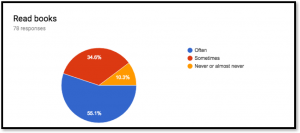SUPPORT FOR LEARNING
Percentage of Children BIOLOGICAL
MOTHERS have engaged in 4hrs or more activities (during last 3 days):Nigeria: 22.1%
North Central: 30.3%
North East: 15.4%
North West: 19.8%
South East: 56%
South South: 52.1%
South West: 48.2%Source: @nigerianstat
— StatiSense (@StatiSense) May 27, 2018
The two tweets above by @StatiSense in a thread on Twitter got me thinking about some of the easy ways parents or adults in general can engage with children in educational activities that would lead to positive life’s experiences for the children, and at the same time bond the adults and the children together in a healthy relationship, hence, I decided to write this blogpost on “Why You Should Read Aloud to Your Child”. Although, the blogpost seems to address parents and their girl-child, however, it is meant for any adult that is interested in children’s educational wellbeing, regardless of gender. The use of she or her throughout the post was just as a matter of convenience.
I think story telling was my life. I was very curious about story telling. Even attempting to remember the first one is like trying to remember the day you were born. I’m not sure you can.
– Late Chinua Achebe (on CNN)
While it is natural that the level of conversation that goes on in every household varies depending on the particular family setting, giving some children advantage over others right from infancy – in terms of their literacy and language skills – as a result of such conversations. While some children could become highly disadvantaged – literacy wise or educationally – due to the level of conversations around them, reading books to children offers a way out of the disadvantage. So, where do we go from here? Conversation is the prime garden in which vocabulary grows, and conversations vary greatly from home to home. It is in light of this that adults should read aloud to children because a new or old book contains the same content (words), regardless of the reader or listener, so far it is written by the same author and has the same title.
This brings me to a recent conversation I had with my little girl. For a couple of weeks, we were reading the same book “I Don’t Want to Go to Bed” by Toni Ross – over and over again – and when I showed her another book “Time for Bed, Little One” by Caroline Pitcher and Tina Macnaughton, and then read out the title to her she nodded her head saying no. This small conversation I found amusing, not for the nature of the response, but for the special bond it created and for the fact that through books we were both able to communicate on an important issue like going to bed, even though she is just 2 years old. Hence, when we read aloud to a child we are helping the child’s brain to get accustomed to words, proper sentences, grammar rules and above all we are helping her to develop empathy and love for reading.
In the novel “To Kill a Mocking Bird” by Harper Lee; Scout the daughter of Atticus informs us how she learnt to read without learning to read formally:
“…Miss Caroline came to the end of the story and said, “Oh my, wasn’t that nice?”
Then she went to the blackboard and printed the alphabet in enormous square capitals, turned to the class and asked, “Does anybody know what these are?” … as I read the alphabet a faint line appeared between her eyebrows, and after making me read most of My First Reader and the stock-market quotations from The Mobile Register aloud, she discovered that I was literate and looked at me with more than faint distaste. Miss Caroline told me to tell my father not to teach me anymore, it would interfere with my reading.
“Teach me? I said in surprise. “He hasn’t taught me anything, Miss Caroline. Atticus ain’t got time to teach me anything,” I added, when Miss Caroline smiled and shook her head. “Why, he’s so tired at night he just sits in the living room and reads.”
If he didn’t teach you, who did? Miss Caroline asked good-naturedly.” Somebody did. You weren’t born reading The Mobile Register.” …
…Now that I was compelled to think about it, reading was something that just came to me, as learning to fasten the seat belt of my union suit without looking around, or achieving two bows from a snarl of shoe laces. I could not remember when the lines above Atticus’s moving finger separated into words, but I had stared at them all evenings in my memory, listening to the news of the day…anything Atticus happened to be reading when I crawled into his lap every night. Until I feared I would lose it, I never loved to read. One does not love breathing.”
While the conversation above in ‘To Kill a Mockingbird’ is fictional and should not be used to claim that children do not need to learn how to read through the decoding of words etc. the conversation shows the power of modelling in developing reading habit in a child. Thus, the question of who should read to a child arises? Should it be the child’s mother, father, teacher or who? The simple response is – we all should inculcate the habit of reading to children, what is most important is to do it consistently on a daily basis. Good children’s books give adults to be in the world of children, have meaningful conversations with them and share special times that will become lifetime’s fond memories when the child becomes an adult. Perhaps, you remember your childhood when you listened to bed time stories or courtyard stories that were full of moral values. Similar to the role traditional storytelling plays, reading aloud to a child can play a similar role in our digitalised world. Thus, it becomes important that the adults in a child’s life, i.e. parents, teachers and siblings read aloud to the child, in order to tell the child about: values, beliefs, customs, traditions, nations, history, interests and above all, give the child an invaluable gift in life – the love for books and reading.
Having talked about why we need to read to children, it is important to talk about when to start and the best time to start is now, irrespective of the situation you find yourself in. There is a saying that – the earlier the better, but there is also the saying that – it’s never too late. So, whatever state you are in now, the best time to start is now irrespective of the child’s age. Hence, a child is ready to be read to the moment that the child is ready to be talked to. After all, reading to a child from cradle will enrich the child’s vocabularies from infancy. As for when to stop reading to a child, I would advice you do this into adulthood and make it a lifetime project as the bond created by reading aloud to a child can never be underestimated. Encourage her to engage in Free Voluntary Reading (FVR). This means reading because she wants to. It means no: book report, questions at the end of a book’s chapter and looking up on the meaning of every word. It means putting down a book she doesn’t like and choosing another one instead. This is the kind of reading highly literate people do all the time.
It is important to have a family library. If you’re like me, then you probably would want to have more books than you might most likely be able to read in your lifetime. Stock your family’s library with different types of books: picture, fact, dictionaries, series, DIY, adventure, history, science, religious etc. Perhaps, you’re beginning to ask yourself – where is the space in my house that I can keep that many books or how can afford so many books or where would I even keep them safely? Well, you can keep books in a book-basket or even get a cardboard box from your local supermarket or shop and use it to keep books safely and tidily in a corner in the house. Likewise, if you have enough space you can dedicate some spaces in your house for bookcases or better still a whole room, if you can afford the luxury. Alternatively, you can construct shelves and keep your books on them or use part of your wardrobe to keep books in your room, if you’re really tight of space. And what about the cost of buying these books or how many do I have to keep? This is subject to individual’s situation: financial, interest or availability of space to keep the books. I would suggest you start small and buy regularly. Look for deals online or in your local bookstores. There are always opportunities to acquire good books around you, if you pay attention to your immediate environment.
When I was living in Lagos, I used to explore roadside bookstalls and used bookstores at CMS area on Lagos Island and around Tejuosho market in Yaba on the mainland. I used to marvel at how cheap it was to get very good used children’s books at an average cost of #100 to #200 per book. And when I moved to the UK, I still found a similar pattern in the availability of cheap and very good used children’s books in charity shops, library sales and car boot sales. The only downside to going into a used bookstore is that you might not always get the book you want, if you had a particular book in mind – Amazon is your friend for that – but you would always discover new gems and perhaps, some old ones you’ve been on the lookout for. And remember, your local library is a free option and you can always create a book exchange or sharing programme with family and friends.
Make sure you stock your library with books that are age appropriate and that she would like to read – your easiest guide is to check the publishers’ age guidelines online or you can use your intuition and the more you get into the habit of reading books to her the better you’ll become in judging which books are more appropriate for her to read and comprehend their stories. But what about the types of books, especially for toddlers and struggling readers? Talking as a parent, I’ve found picture books to be very great in engaging young children in the act of developing listening and reading skills. Talking about picture books, I have found out that good picture books are usually sequential in their storyline; they usually have words and pictures that are in tandem with each other and that lead to easy understanding of their stories. They always have good beginnings, middle and endings to their stories. They are able to convey complex concepts in very simple ways to children, even to toddlers. For example, books like ‘Handa’s Surprise’ by Eileen Browne, ‘The Very Hungry Caterpillar’ by Eric Carle and ‘The Greedy Triangle’ by Marilyn Burns are some of the fantastic children’s books that are able to convey complex concepts in simple ways to children that I have read.
Finally, it’s important to talk about the do’s and don’ts of reading aloud to children, and here are some of them:
Read Aloud Do’s:
- Read what you like and like what you read.
- Read the right books at the right time – choose books that speak to both the appropriate reading level of the child and her developmental readiness for the story.
- Respect her taste but know that your guidance is required in helping her find books worth knowing with characters worth meeting.
- Keep the pleasure in Reading. If a book is too difficult, it might be better understood and enjoyed by her if it was read aloud to her. Because a child’s listening comprehension is likely to be higher than her reading comprehension. Also, encourage her to read another book on her own for pleasure.
- Read Aloud. Part of a child’s desire to learn to read comes from being read to. Reading to her taps into her imagination, curiosity, and creates a love for stories. By reading aloud to her, she would learn some of the basic reading skills like fluency and inflection.
- Slow Down: encourage her to read fewer books and know them well. Children need comprehension not speed to be good readers.
- Encourage her to read a book more than once. Repetition builds comprehension.
- Audio books (not the abridged stories) are terrific. Listening to books while driving, walking, and exercising or with an iPod, mp3 player, mobile phone etc. on the bus or train is great and is time spent wisely.
- Create time in the day when reading can happen. Bedtime reading is wonderful but it is not the only time of the day to read. You can establish read aloud during breakfast, lunch, dinner periods or any other suitable time.
- Expect her to love reading and support her expectations by helping her to find books that she loves.
Read Aloud Don’ts:
- Don’t interrupt the reading of the story with explanations or editorials, these get in the way of the story. She can easily become disengaged and frustrated with too many interruptions.
- Don’t stop reading aloud to her once she has mastered the ability to read on her own. Some children, when they can read on their own, resist being read to – it can feel babyish. Reading aloud, sharing ideas, and talking about what matters to her is not something that anyone outgrows. Be creative, read something that will interest her and keep alive the habit of reading together and sharing ideas.
- Don’t turn reading into a vocabulary lesson; learning words in isolation can easily get in the way of comprehension and pleasure.
- Don’t read while the TV/DVD/Video game or computer is on.
- Don’t read aloud to her while she is deeply engaged in another activity and don’t stop her in order to read aloud to her; remember, it is pleasure and not labour seeking approach to reading that is the goal
REFERENCES AND SUGGESTED READING:
- Ready, Set, Read! A Start – To – Finish Reading Program Any Parent Can Use by Barbara Curtis.
- Read for Your Life: 11 Ways to Better Yourself Through Books by Pat Williams, Peggy Mathews Rose and Phil Jackson.
- Better than Life by Daniel Pennac.
- The Read Aloud Handbook: Sixth Edition by Jim Trelease.
- Reading magic: Why reading Aloud to Our Children Will Change Their Lives Forever by Mem Fox and Judy Horacek.
- Reading Together: Everything You Need to Know to Raise a Child Who Loves to Read by Diane Waxer Frankenstein.
- Read for Your Life by Gladys Hunt and Barbara Hampton.
- Baby Read Aloud Basics: Fun and Interactive Ways to Help Your Little One Discover the World of Words by Caroline J. Blakemore and Barbara Weston Ramirez.
- Great Books about Things Kids Love: More Than 750 Recommended Books for Children 3 to 14 by Kathleen Odean.
- The Power of Reading by Prof. Stephen D. Krashen.
- Handbook for Small, Rural, and Emerging Public Libraries by Anne Gervasi and Betty Kay Seibt.
Some Useful Websites:
Note: part of this post has been published in the past as a training handout and online on two blogsites but all the content – therein and herein – were written by me.
Please, leave your thoughts on this post in the comment section and feel free to share the article with your contacts. Thanks for taking out of your precious time to read my article/s!
If you like this post, kindly subscribe and/or follow me on Twitter @otukogbe and @EdusoundsNg or on Facebook at edusoundsng.





